Blog Posts Tagged CFD Module
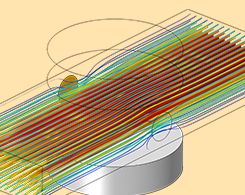
Building a Magnetohydrodynamic Multiphysics Model in COMSOL®
Magnetohydrodynamic models call for fluid dynamics and electromagnetics couplings. To do so, you can set up bidirectional couplings between all physics equations or building a simplified model.
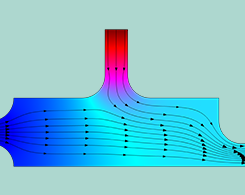
Optimizing PID Controller Performance with COMSOL Multiphysics®
PID controllers involve three components that must work together simultaneously, and it can be challenging to get each of them just right. That’s where process control simulation comes in.

Speeding Up DNA Separation in a Microchannel via Simulation
DNA separation takes a long time using traditional methods. Now, researchers from the Missouri University of Science and Technology have found a faster way to get the job done.

Calculating the Heat Transfer Coefficient for Flat and Corrugated Plates
What is the heat transfer coefficient, and how do you calculate it? This blog post includes a theoretical background and demonstration of 2 examples in COMSOL Multiphysics®.

Simulation Applications Enable Digitalization at ABB Traction Motors
Here’s a real-world example of optimizing R&D processes with COMSOL Server™: At ABB Traction Motors, engineers use simulation applications to analyze CFD and heat in electric motor designs.

Keynote Video: Optimizing Cable Systems via Simulation
The length of cable for a mode of transportation depends on the amount of passengers, so a car uses ~5 km of cable and a cruise ship uses ~5000 km. Learn more about cable system design here.

Keynote Video: EPFL Uses Simulation to Design a Hyperloop Pod
The EPFLoop team used multiphysics simulation to design the aeroshell, pressure vessel, and braking system of their hyperloop pod for the SpaceX 2018 competition. Get an inside look here.

2 Mesh Adaptation Methods: Enabling More Efficient Computations
Why adapt your mesh? For one thing, it helps you solve your computational problems more efficiently. Here, we show you 2 methods for adapting your mesh in COMSOL Multiphysics®.
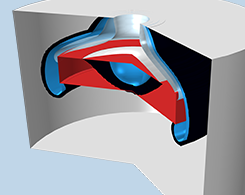
Simulating Multiphase Flow in Porous Media with a Low Permeable Lens
Modeling phase transport helps you study the multiphase flow through a porous medium (such as groundwater through soil).

Studying Shock Wave Phenomena with a Shock Tube Application
Shock waves used to be a theoretical problem only. Then, shock tubes enabled experimentation, but it was costly and inefficient. Enter numerical modeling applications.

Keynote Video: Designing Improved Heart Pumps with Simulation
Abbott Laboratories designed “the most complex machine ever implanted into a human being” — an LVAD for heart failure patients — using multiphysics modeling. The result? Saved lives.

FEM vs. FVM
Finite element methods, finite volume methods, or a hybrid approach: Which is the best choice for CFD? It depends on the fluid flow problem you’re trying to solve.

Improving Architectural Designs with Building Physics Simulation
Building physics simulation can help engineers develop more energy-efficient architectural designs. We talked to Built Environments, Inc. to get a few examples of how.
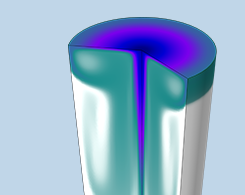
How to Model Sparging in COMSOL Multiphysics®
Sparging, the process of bubbling a gas into a liquid, is seen most notably in carbonation, such as for soda and seltzer water. This mass transfer process can be modeled in COMSOL Multiphysics®.

How to Place Inlet and Outlet Boundary Conditions in CFD Simulations
When setting up fluid flow simulations, at what distance can we apply boundary conditions without interfering with the process? Here, we discuss how to place inlet and outlet boundary conditions.

Describing Viscoelastic Behavior with an Oldroyd-B Benchmark
The Oldroyd-B model is used to define viscoelastic behavior in fluids such as clay, toothpaste, and oil. We present a benchmark model for a fluid with viscoelastic behavior under strain.

CFD Benchmark: Examining Fluid Flow in a Transonic Diffuser
You can analyze the fluid flow in a transonic diffuser using CFD simulation. Get details in this blog post featuring a benchmark model based on research by M. Sajben et al.

How to Analyze a Glacier via Gradient-Based Optimization
This post highlights a gradient-based optimization method that geophysical engineers can use to analyze, for instance, the movement and sensitivity of a glacier.
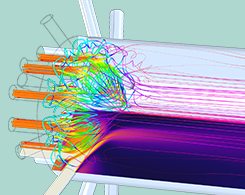
Modeling a Tubular Reactor for Optimized Polymer Manufacturing
Chemical engineers can model tubular reactors to optimize them for specific manufacturing and production processes, such as for the polymerization of polyester, as this example shows.
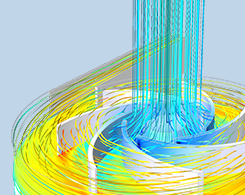
Analyzing a Centrifugal Pump Design with Frozen Rotor Approximation
Mechanical engineers can analyze the design of centrifugal pumps using the Frozen Rotor Approximation, which is available in the Mixer Module, an add-on to the CFD Module.

Your Guide to Meshing Techniques for Efficient CFD Modeling
Learn how to use a variety of meshing tools for your CFD analyses, including mapped mesh, unstructured quad mesh, triangular mesh, tetrahedral mesh, swept mesh, boundary layer mesh, and more.

How to Set Up a Mesh in COMSOL Multiphysics® for CFD Analyses
As a flow mechanics specialist preparing a mesh for CFD analysis, the geometry supplied by a CAD team is often exactly what you do not want. So, what do you do?

Does It Matter Which Ball the FIFA World Cup™ Teams Practiced With?
In an attempt to determine what type of soccer ball is best to prepare for the FIFA World Cup™, we set up a backyard experiment involving a leaf blower, level, and a few soccer balls.

Optimizing Combustion Particle Control in an Electric Filter Design
To optimize the design of an electrostatic filter, researchers from Switzerland used multiphysics modeling, validating their results by comparing them to experimental data.
